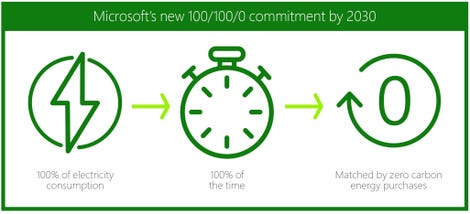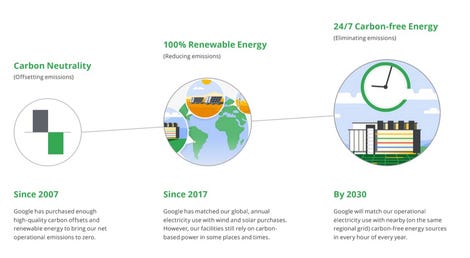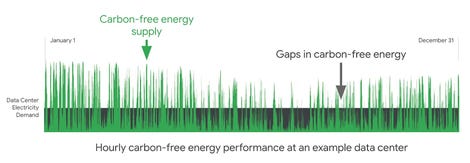For a professional, it becomes very difficult to work on a daily basis without the cloud. Our daily tasks are increasingly digital, supported by tools and services based on a remote server farm. The “cloud”, after all, is just someone else’s computer (or server).
The “cloud” therefore allows, among other things, a relatively low carbon footprint, by allowing people to accomplish many things remotely, such as teleworking. At the same time, it is easy to forget that the “cloud” has its own carbon footprint, left by data centers.
“At the end of the day, the internet runs on data centers, and operationally, data centers run on power,” Google’s Maud Texier told ZDNET. “So that’s the main source of greenhouse gas emissions – when someone is using the cloud or writing an email.”
Before trying to determine how green the “cloud” is, it’s worth revisiting what exactly the “cloud” is. This technical term simply refers to computer services provided over the Internet. This definition covers applications like Instagram or Google Search to basic computing services like processing power and data storage. Businesses can choose to run their digital operations on their own servers (usually in an on-premises data center) or through a cloud service provider like Google Cloud, Amazon Web Services, or Microsoft Azure.
More data does not mean more power consumption
Given the explosion of the digital economy over the past two decades, it would be easy to assume that the carbon footprint of the cloud has also increased. This is not the case.
Research published in 2020 shows that the computing power of data centers increased by 550% between 2010 and 2018. However, the energy consumption of these data centers only increased by 6%. In 2018, data centers consumed about 1% of global electricity production.
The technology sector has successfully brought its energy consumption needs under control by making huge improvements in energy efficiency.
Cloud computing and data centers
The migration to the cloud is substantial. The share of enterprise data in the cloud has grown from 30% in 2015 to 60% in 2022.
But most organizations aren’t moving to the cloud to make their operations more sustainable, notes Miguel Angel Borrega, director of cloud infrastructure strategies at Gartner. “There are other variables that are even more important than sustainability,” he tells ZDNET – like cost savings or the ability to take advantage of the latest technologies from Google and Microsoft. That said, durability ends up being a clear advantage as well.
“When we compare gas emissions, energy efficiency, water efficiency and how efficiently they use IT infrastructure, we realize that cloud is better,” explains Mr. Borrega.
One of the main reasons service providers might operate more efficiently, he says, is simply that their infrastructure is newer and more efficient. Many enterprise data centers are 30 or 40 years old, which means they are not taking advantage of recent gains in energy efficiency.
Renewable energy
One of the main factors in reducing greenhouse gas emissions is the use of renewable energy sources. Traditional data centers are powered by energy often from fossil fuel sources, but new cloud computing regions are increasingly harnessing renewable energy.
In cases where they cannot use renewable energy, cloud computing companies are increasingly committed to offsetting their energy consumption with carbon credits. For example, Microsoft has committed that 100% of its electricity consumption is offset by carbon-free energy purchases by 2030.

Source: Microsoft
“Our data centers simply plug into the local network, drawing power from a vast reservoir of electrons generated from a wide variety of sources,” Microsoft executives wrote at the time. “So while we can’t control how our energy is produced, we can influence how we buy our energy.”
Amazon, meanwhile, says it is on track to power all of its operations with 100% renewable energy by 2025. This includes Amazon’s operational facilities, company offices, and data centers. of Amazon Web Services (AWS). The company is committed to achieving zero carbon across all of its operations by 2040.
Google began rolling out its cloud computing sustainability efforts in 2007 by purchasing carbon credits. In 2010, she started finding clean energy sources and adding clean energy to the grid to offset her consumption. And since 2017, the company has been buying enough renewable energy to offset its consumption.

Source: Google
In 2020, Google started tracking a new metric, the carbon-free energy percentage (CFE% – carbon-free energy). This metric represents the average percentage of carbon-free energy consumed at a particular location on an hourly basis, while accounting for the carbon-free energy that Google has added to the grid at that particular location. So for businesses, the CFE% represents the average percentage of time their applications will run on carbon-free power.
In 2020, Google also set a goal to match its energy consumption to carbon-free energy (CFE), every hour and in every region, by 2030. Last year, M Texier said about two-thirds of Google’s power consumption relies on EFC.

Source: Google
“There is still work to do,” she says. “It’s going to become a lot more regional – how do you talk to regional stakeholders and utilities as they try to change the networks?”
Where does your cloud run?
Location is an important aspect to consider for anyone trying to assess how “green” a specific cloud is, says Maud Texier. Some of Google’s data centers, located in places such as Finland, Canada and the United States, have a CFE% greater than 90. Others, such as the data centers in Singapore and Indonesia, are closer 10 or 20%.
Source: Google Carbon Regions
“That was one of the biggest realizations that came to us when we moved from this big, annual goal to this smaller, more specific, 24/7 goal,” she says. “In fact, there is a very high variability within the portfolio. And we have to be much more surgical in terms of the roadmap for each data center.”
Become more efficient
As cloud service providers work with the energy industry and regulators to create more renewable energy options, they are also becoming more efficient at managing their operations. A data center needs a lot of power to run workloads, maintain data storage, run cooling systems, distribute power, and more. With advances in areas such as refrigeration and cooling systems, cloud service providers can devote more energy to providing computing power.
At the same time, cloud computing service providers can offer efficient server utilization.
“Imagine you have a server that can support 100 workloads,” says Borrega. “Normally what we find is that to run this volume of workloads, on average, the [centres de données] only use 40% of their IT resources. But we power them with all the energy to support this potential functionality. So in data centers, the normal IT infrastructure is utilized on average at 40%. When we move to cloud providers, the server utilization efficiency rate is 85%. So with the same energy, we handle double or more than double the workloads.”
And at the same time, cloud computing providers are managing workloads more efficiently by designing new technologies. AWS, Google, and others build their own custom chips and hardware to give customers the most computing power while using the least energy.
Source: “ZDNet.com”

